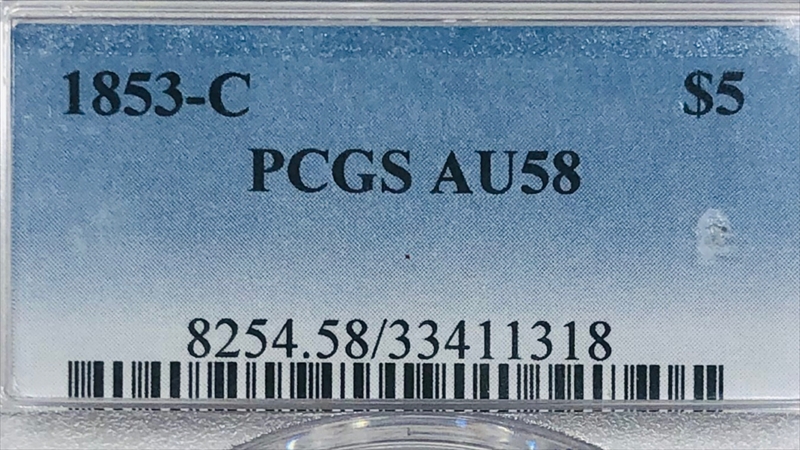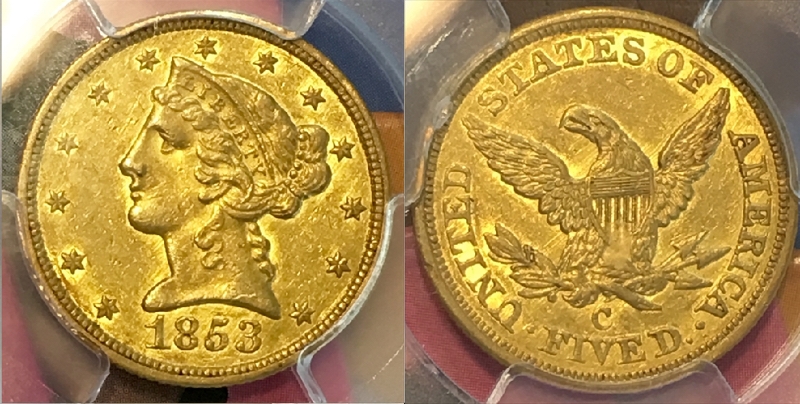1853-C $5 AU58 认证号33411318, PCGS号8254
专家评论
Doug Winter
The 1853-C is one of the more common Charlotte half eagles. It is readily available in Very Fine and Extremely Fine and can be found in the lower About Uncirculated grades without a great effort. It becomes scarce in properly graded AU58 and rare in Uncirculated, with no more than a dozen or so known that qualify as such by today’s standards.STRIKE: The 1853-C half eagle is better struck than the 1852-C. On the obverse, most of the central detail is well defined with the exception of the curls around the face. The curl below the ear is strong. The hair, the top of Liberty’s head and the bun are sharp as well. Many of the stars have completely defined radial lines. The denticles are sharp. The reverse is a bit less bold than the obverse, but it is still better struck than most other half eagles from this mint. The eagle’s feathers tend to be sharper in the left wing than on the right, and both wing tips are often incomplete. The claws and legs range from fully defined to slightly weak. Most have weakness noted on the right leg and the claw. The lettering is sometimes weak on TED in UNITED and STA in STATES. Some 1853-C half eagles are seen with faint mintmarks, although less so than on 1850-C and 1854-C half eagles.
SURFACES: As with other Charlotte half eagles from the early to mid 1850s, the 1853-C is an issue that saw heavy commercial use. As a result, most are very heavily abraded. I have seen but a few that did not have numerous deep, detracting marks in the fields. Examples exist with matte-like surfaces from exposure to saltwater. These supposedly came from a Civil War shipwreck that was salvaged in the early 1970s. They generally have the detail of Uncirculated examples, but are accorded the value of an Extremely Fine with original surfaces.
LUSTER: High grade, original pieces have satiny luster that is slightly reflective in the fields. The small number of known semi-prooflike examples are usually marred by heavy abrasions. While most 1853-C half eagles were cleaned at one point in time and, as a result, show impaired luster, there are still a few choice pieces known with exceptionally thick, frosty luster.
COLORATION: The coloration ranges from a rich green-gold hue to medium orange-gold. Until recently, it was not hard to find an example with original color. Unfortunately, most have been dipped or processed in recent years.
EYE APPEAL: There are still some extremely attractive 1853-C half eagles known. With some patience, the collectors should be able to find a piece with good eye appeal. As stated above, it is hard to find a coin that does not have a significant number of marks on the surface.
DIE CHARACTERISTICS: A few have been seen with small obverse rim cuds, one of which is located at 11:00 while the other is at 2:00.
DIE VARIETIES: Three varieties are known.
Variety 1 (formerly Variety 20-H): The 1 in the date is very close to the bust. The 3 is centered in the field between the bust and the denticles. The reverse was also used in 1852.
This variety is common.
Four die states are known.
Die State I: Perfect dies. The usual die state.
Die State II: A cud is present at 11:00 on the obverse. None shows at 2:00. Rare.
Die State III: Cuds are now seen at 11:00 and 2:00 on the obverse. The reverse die is perfect. Rare.
Die State IV: In addition to the two obverse cuds seen on State III, a die crack is now present from the C in AMERICA clockwise through the bases of the E D in the denomination to the denticles beneath the V in FIVE. Very rare.
Variety 2 (formerly variety 21-H): The date is lower than on Variety 1. The 1 is totally free of the bust and the 3 is closer to the denticles than to the bust. The reverse is the same as Variety 1 and was also used in 1852.
This variety is rare.
There is a late die state known for Variety Two that displays a retained cud between 5:30 and 6:30 beneath the E in FIVE. The discovery example was sold in the Heritage September 2008 auction.
Variety 3 (new variety): The obverse is the same as on Variety 2. The mintmark is located over the E in FIVE and is much further to the right than on the other two varieties. The mintmark was lightly entered into the die and is weak on all examples seen. The reverse was later used to strike 1854-C Variety 2.
David Akers (1975/88)
The 1853-C is rare in all grades and generally available only in VF or EF condition. There are a small number of AU's in existence and also several uncirculated pieces but uncs are certainly extremely rare. A number of "salt water uncs" exist but these are worth far less than a normal uncirculated specimen. As a date, and in condition, the 1853-C is more rare than the 1849-C and 1852-C and is comparable overall to the 1850-C. This date is often softly struck on the hair curls around the face but generally well struck otherwise.
稀有性和存量估计 了解更多
| 所有评级 | 650 |
| 60或以上 | 12 |
| 65或以上 | 0 |
| 所有评级 | R-5.7 |
| 60或以上 | R-9.5 |
| 65或以上 | R-10.1 |
| 所有评级 | 106 / 112 TIE |
| 60或以上 | 59 / 112 TIE |
| 65或以上 | 1 / 112 |
| 所有评级 | 150 / 218 TIE |
| 60或以上 | 87 / 218 TIE |
| 65或以上 | 1 / 218 |
状况普查 了解更多
|
#1 MS64 PCGS grade
Stack's "Bell" 12/1944 - "Memorable Collection" 3/1948 - Stack's "Bareford" 12/1978:173 - Harry W. Bass, Jr. - Bowers and Merena 10/1999:1041 - Heritage 1/2004:3032 - C.W. Collection - American Numismatic Rarities 8/2006:1419, not sold |
| #2 MS63 PCGS grade |
| #2 MS63 PCGS grade |
| #2 MS63 estimated grade |
| #2 MS63 estimated grade |






















